The journey starts at Windhoek International Airport at 10:30 or 15:50. If your international flight arrives late in the afternoon, you need to spend a first night in Windhoek.
The safari ends at Windhoek International Airport at around 3pm. Should you require an earlier arrival in Windhoek for your international flight, we can book an earlier flight at a higher price.
On this fly-in safari you experience the most important highlights of Namibia: the huge sand dunes of Sossuslvei, the coastal town of Swakopmund, the desert adapted elephants of Damaraland and the wildlife in Etosha National Park and in the private Ongava Reserve.

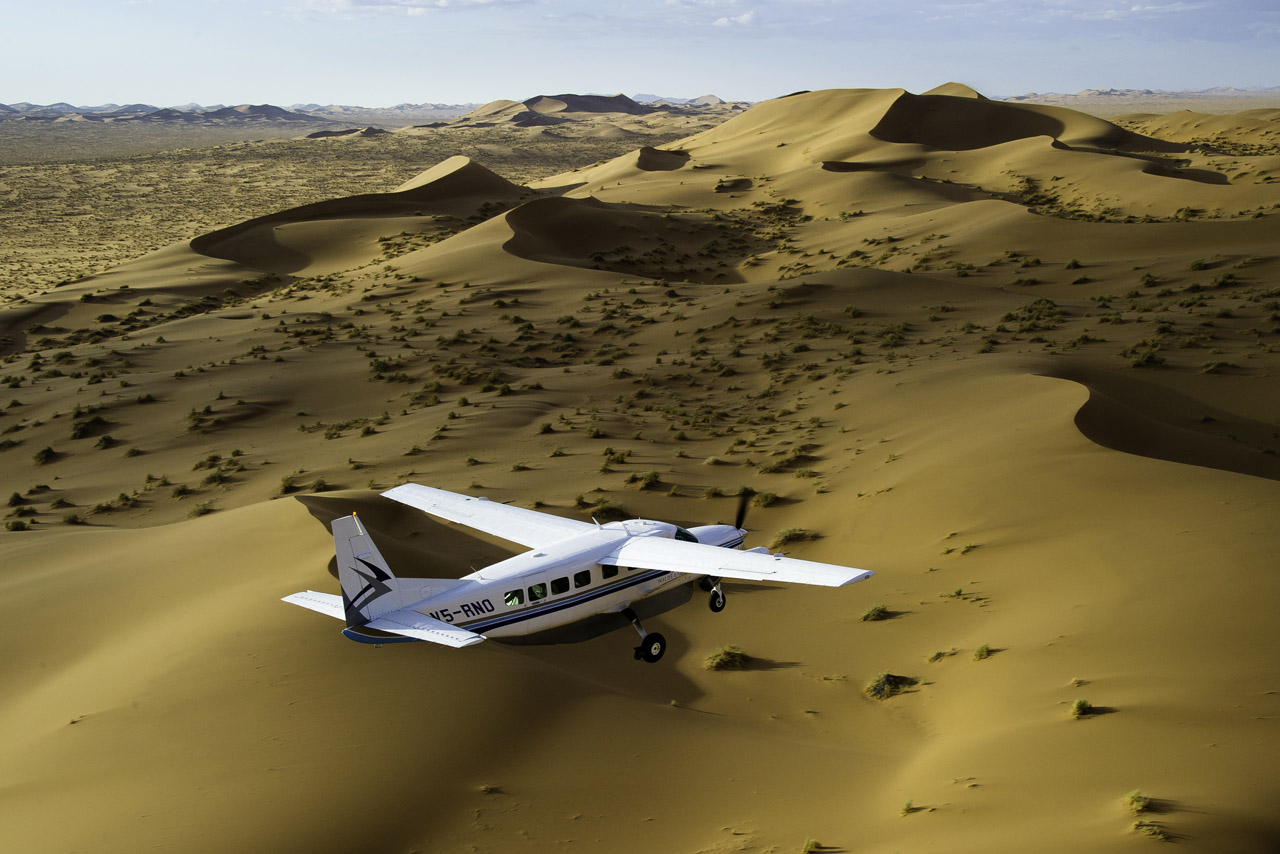

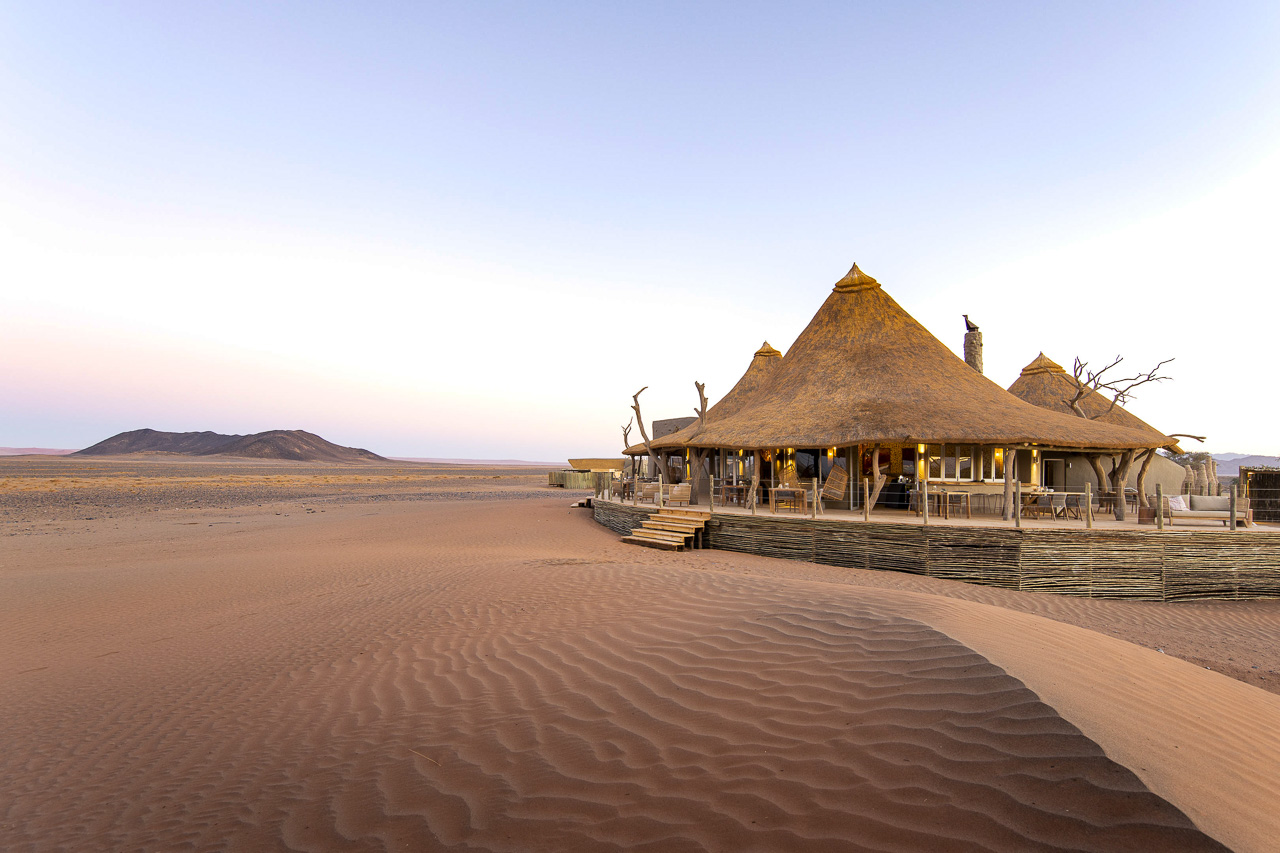
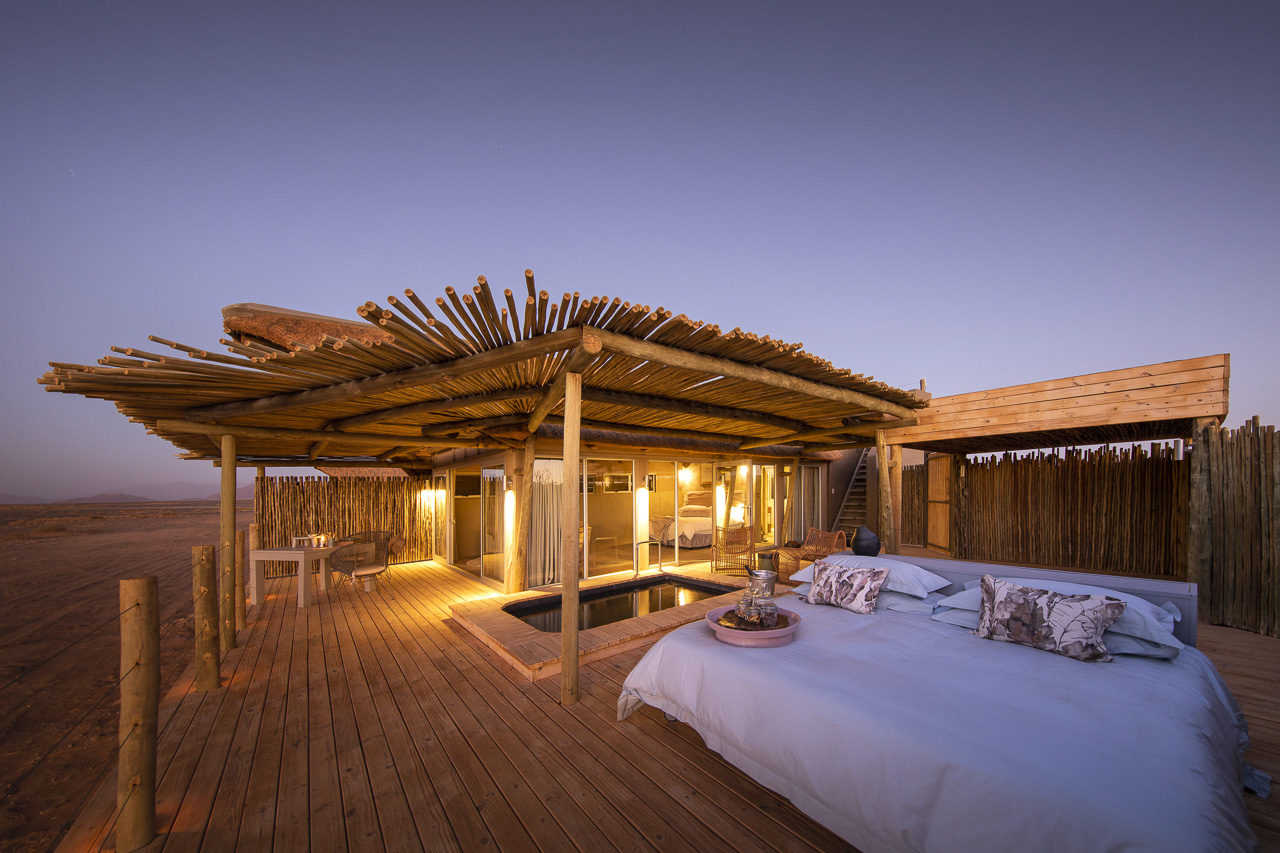
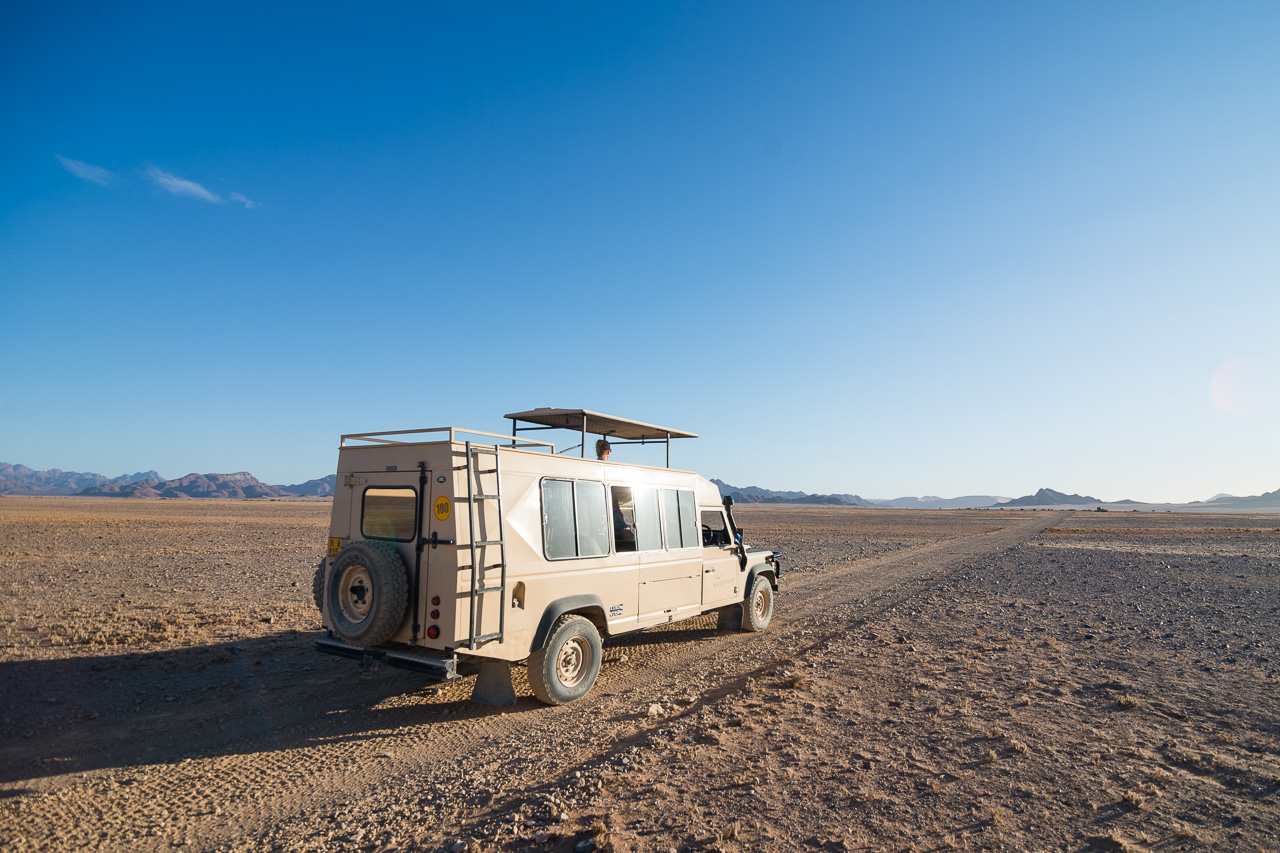
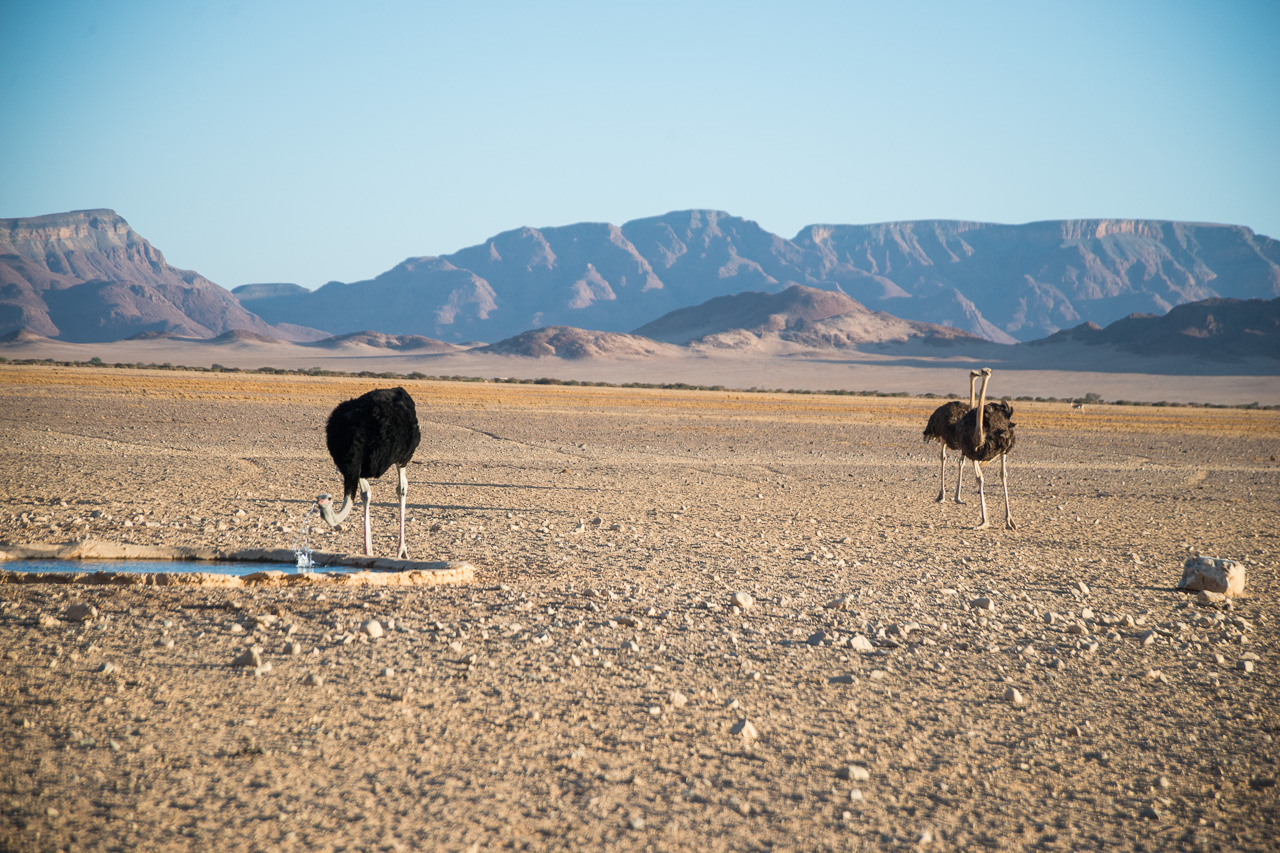
Accommodation
Little Kulala offers eleven climate-controlled rooms (it's very hot in the Namib region from November onwards!) with en-suite facilities, extra outdoor shower, private plunge pool, veranda with outdoor lounge, and a skybed where guests can spend a romantic night under the clear, starry sky.
The camp places great emphasis on natural materials, and the colours of the linen, cotton and mohair fabrics blend seamlessly into the natural surroundings. The Kulala Camps stand out for their fantastic location close to the Sossuvlei dunes and with exclusive access to the park.
Sossusvlei is the area most associated with Namibia: Red dunes as far as the eye can see (up to 380 m high, coloured red by the clay-rich sand) and dead trees in the Vleis or pans, decaying slowly at the will of the arid climate. The Vleis were created by the Tsauchab River, which probably once flowed to the Atlantic some 50 km away. The whole Sossusvlei region is quenched with water during those very rare years when a good amount of rain falls, prompting bushes and flowers to spring up everywhere.
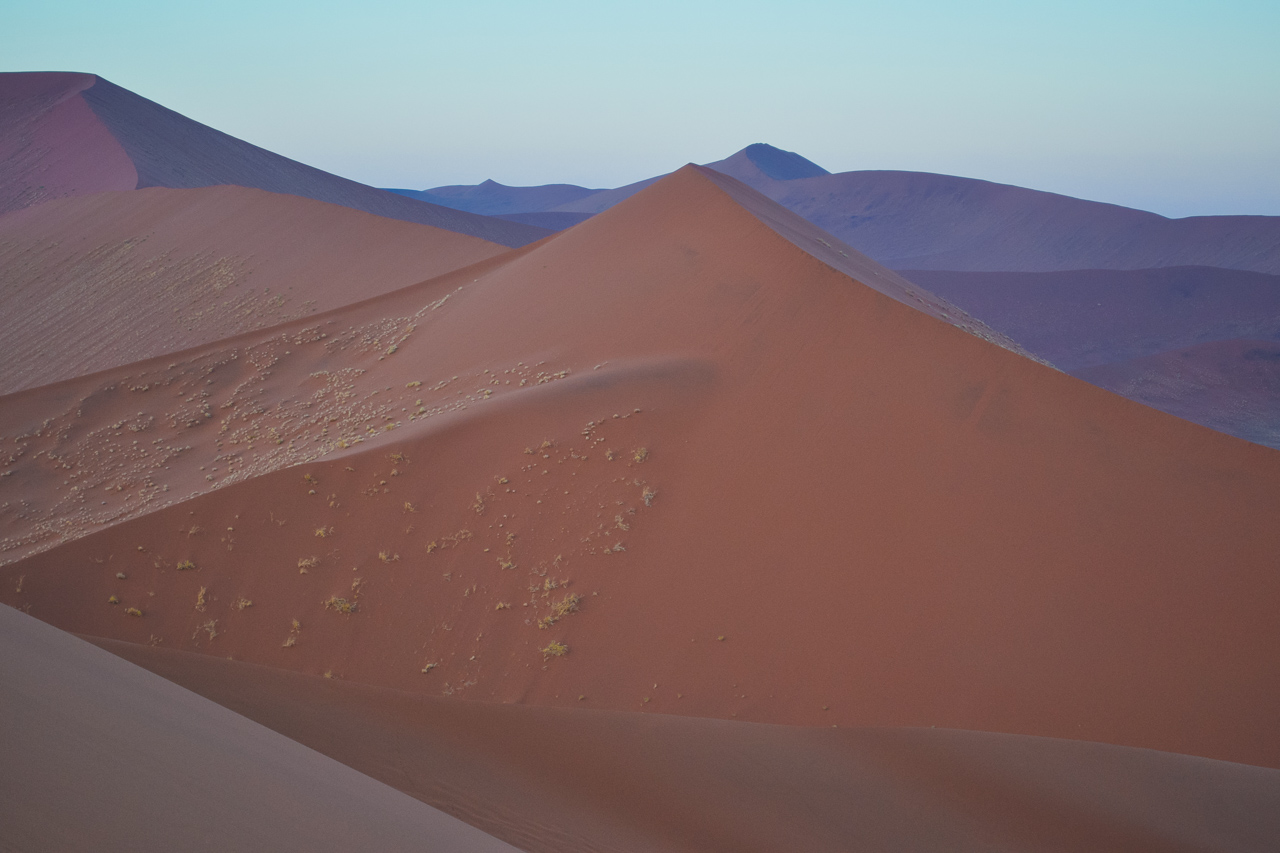
Sossusvlei is also the place most commonly associated with Namibia. Its red dunes stretch as far as the eye can see (up to 380 m high, coloured red by the clay-rich sand) and the desiccated trees in the vleis (salt and clay pans), which decay slowly due to the arid environment, are typical of the region. The vleis were created by the Tsauchab River, which most probably flowed into the Atlantic 50 km away. Very rarely, a torrential downpour will see the vleis disappear under water – a spectacle that very few get to see. .
The Namib itself is a product of the Orange River in the south, which carries the red sand of the Kalahari to the ocean. The Benguela Current takes the sand north, where the prevailing winds have blown it back inland over millions of years, forming the Namib Desert.
Sossusvlei is situated in the Namib Naukluft Park and thus subject to very strict regulations. The park opens its gates at sunrise and all visitors are required to leave again by sunset. The distance between the park entrance and the Sossusvlei car park, however, is a good 60 km, most of which is tarred. From here it’s only possible to reach the second car park, right next to the Sossusvlei, in a 4x4, on foot or using the shuttle service. There are also other vleis in the area in addition to the Sossusvlei, including Dead Vlei, with its famous dead trees, and somewhat further away, the so-called Hidden Vlei, which requires a good trek to get to.
The most famous dunes are Dune 45 (170 m high), which is located 45 km from the entrance to Sossusvlei, and then Big Daddy, the largest dune, and his partner, Big Mama. Visitors are of course allowed to scale the dunes, and the effort is worth it. The way up is quite strenuous – but this also means that the way down is easy!
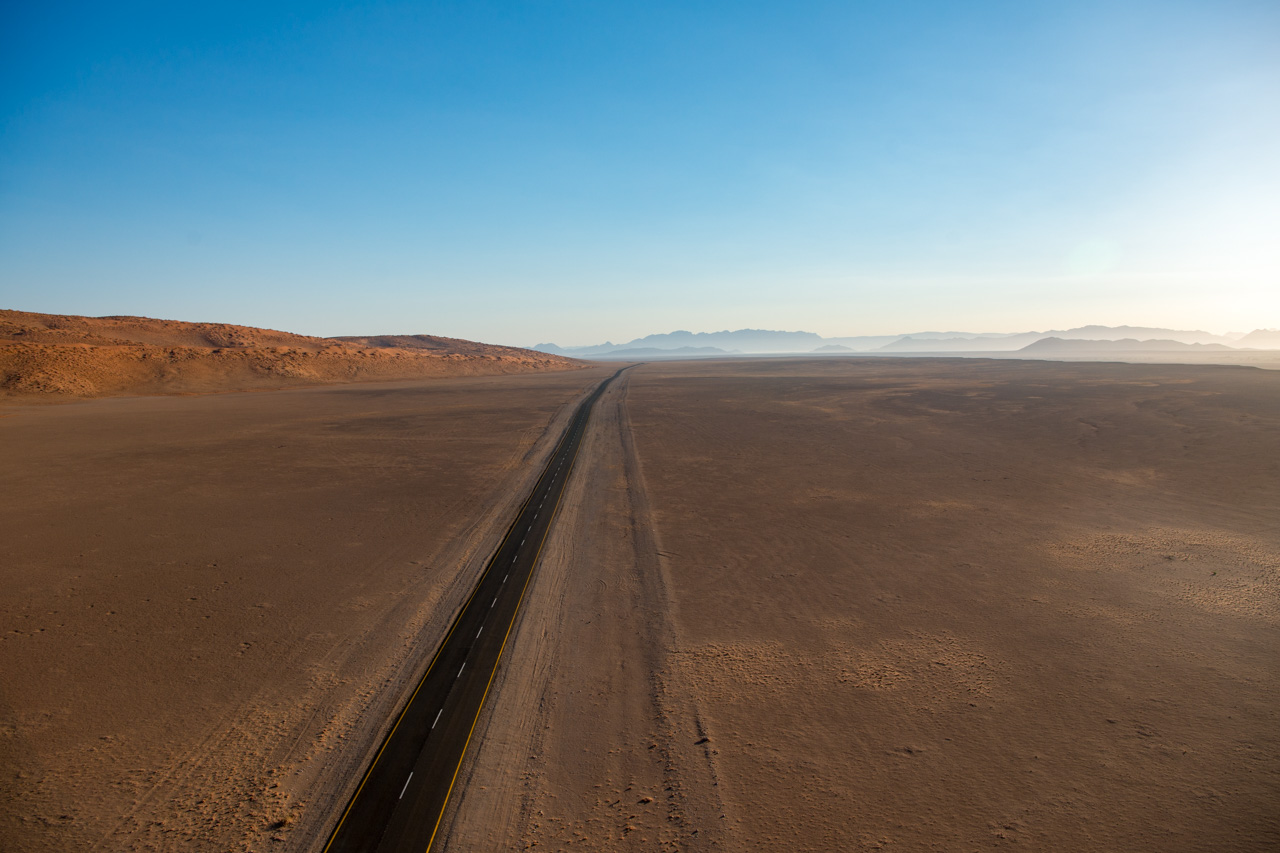
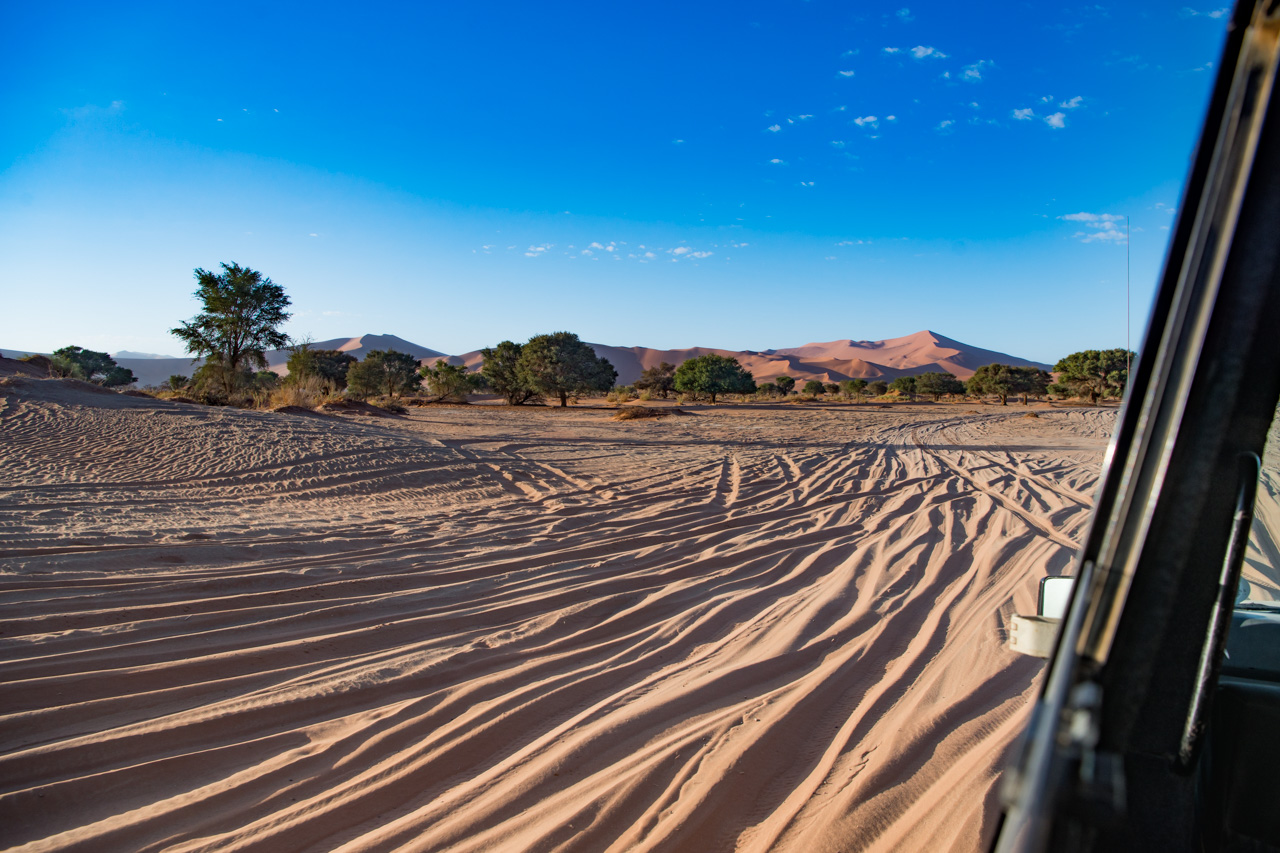
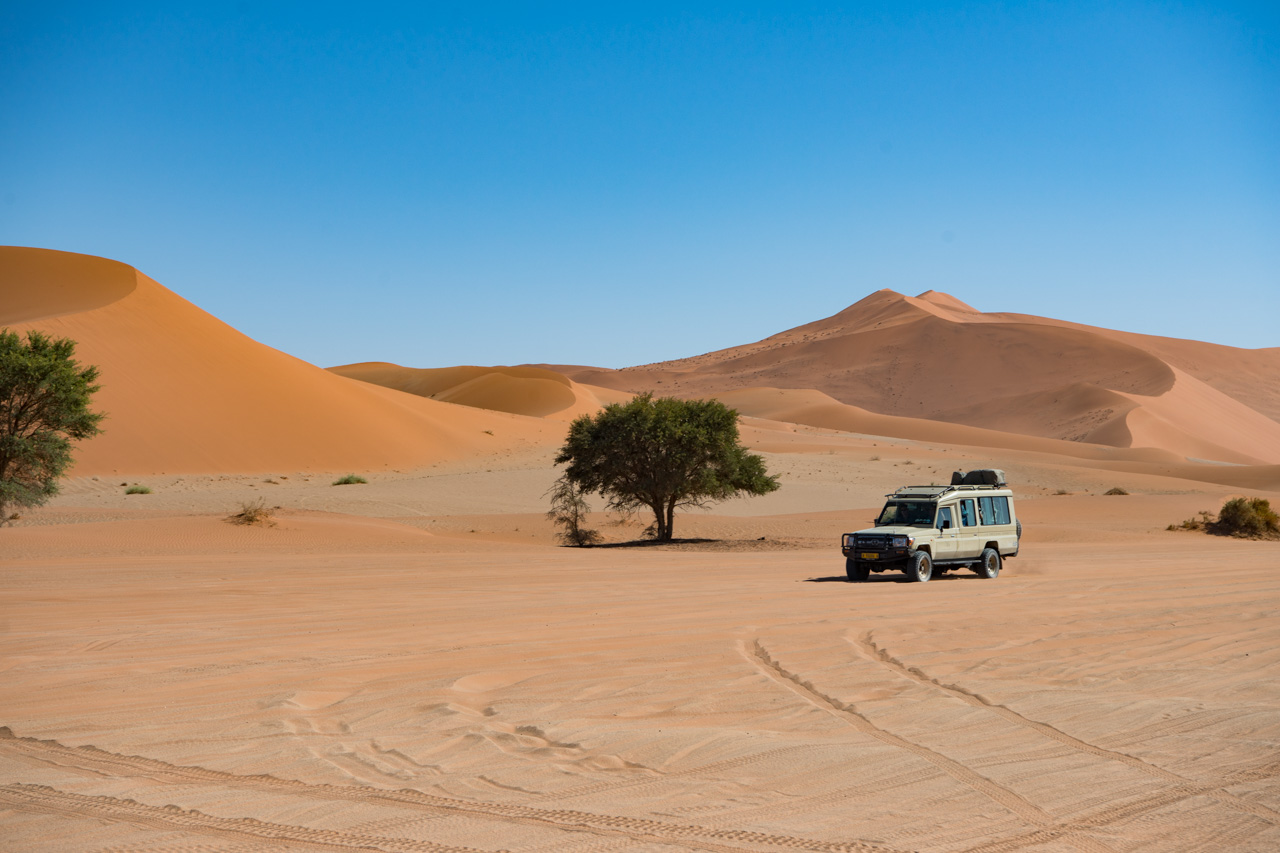

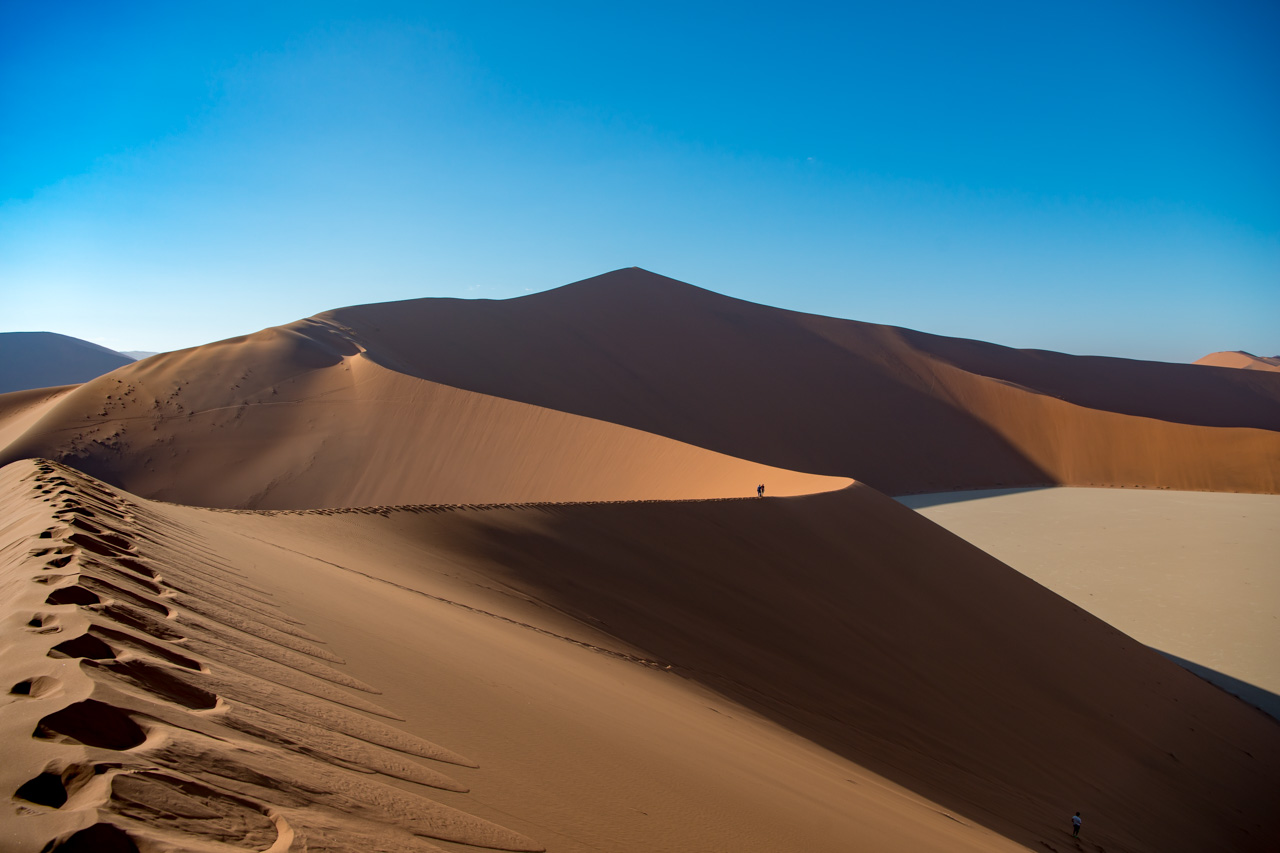
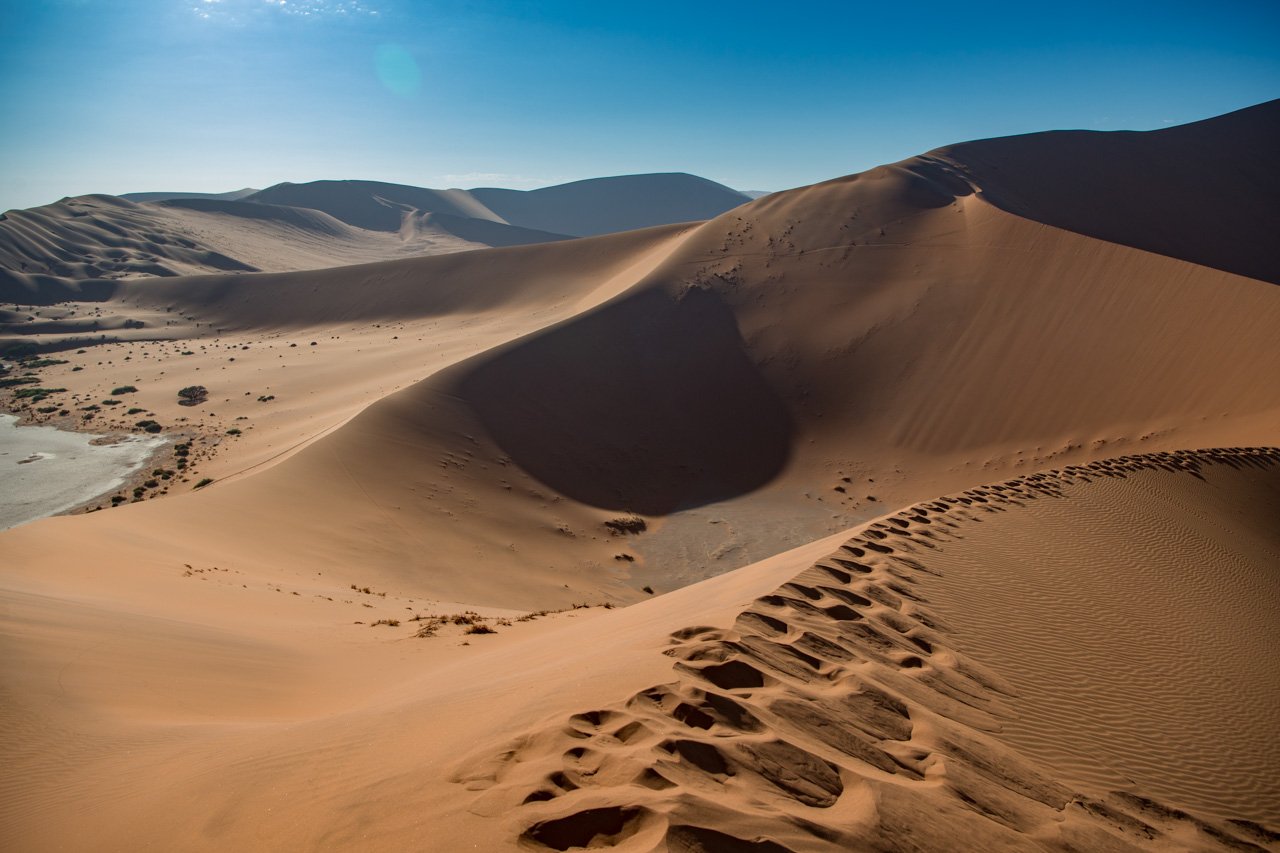
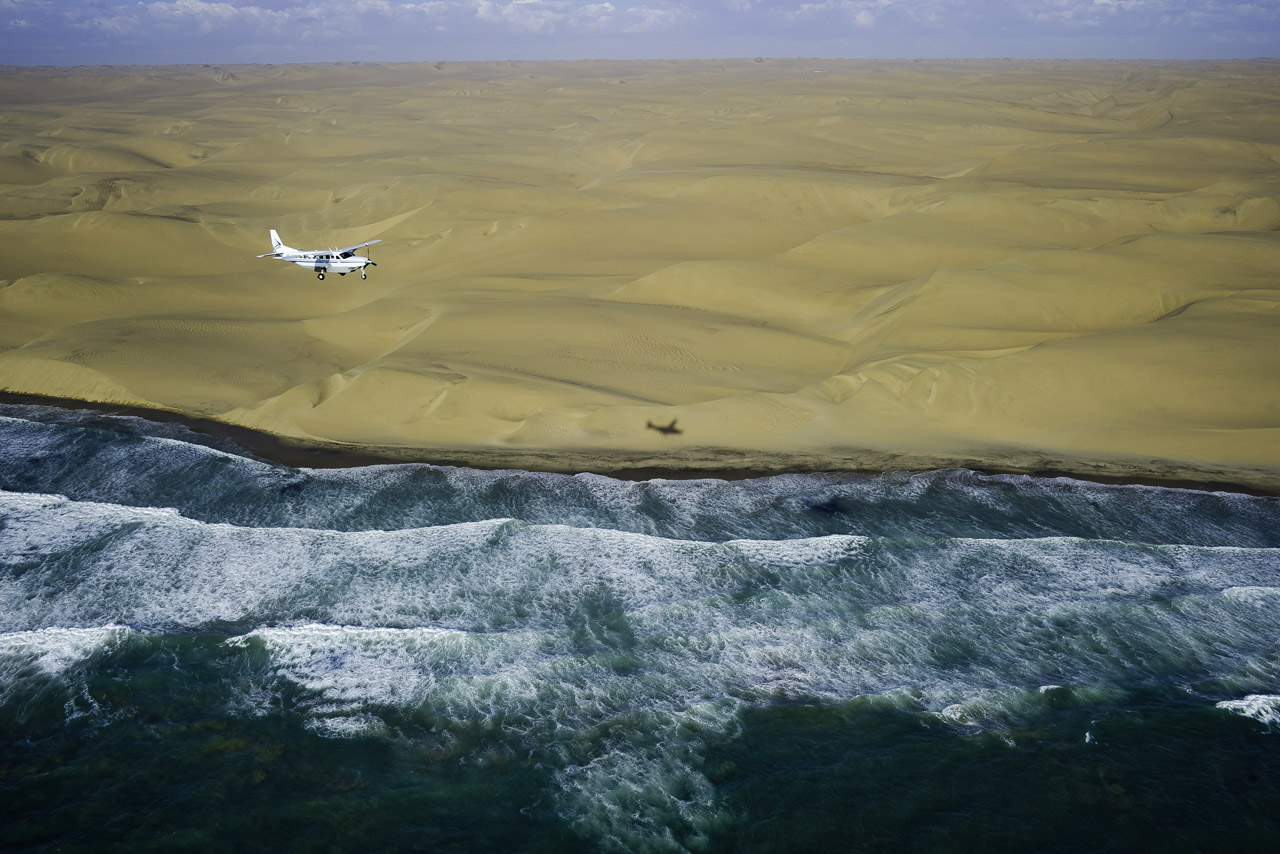
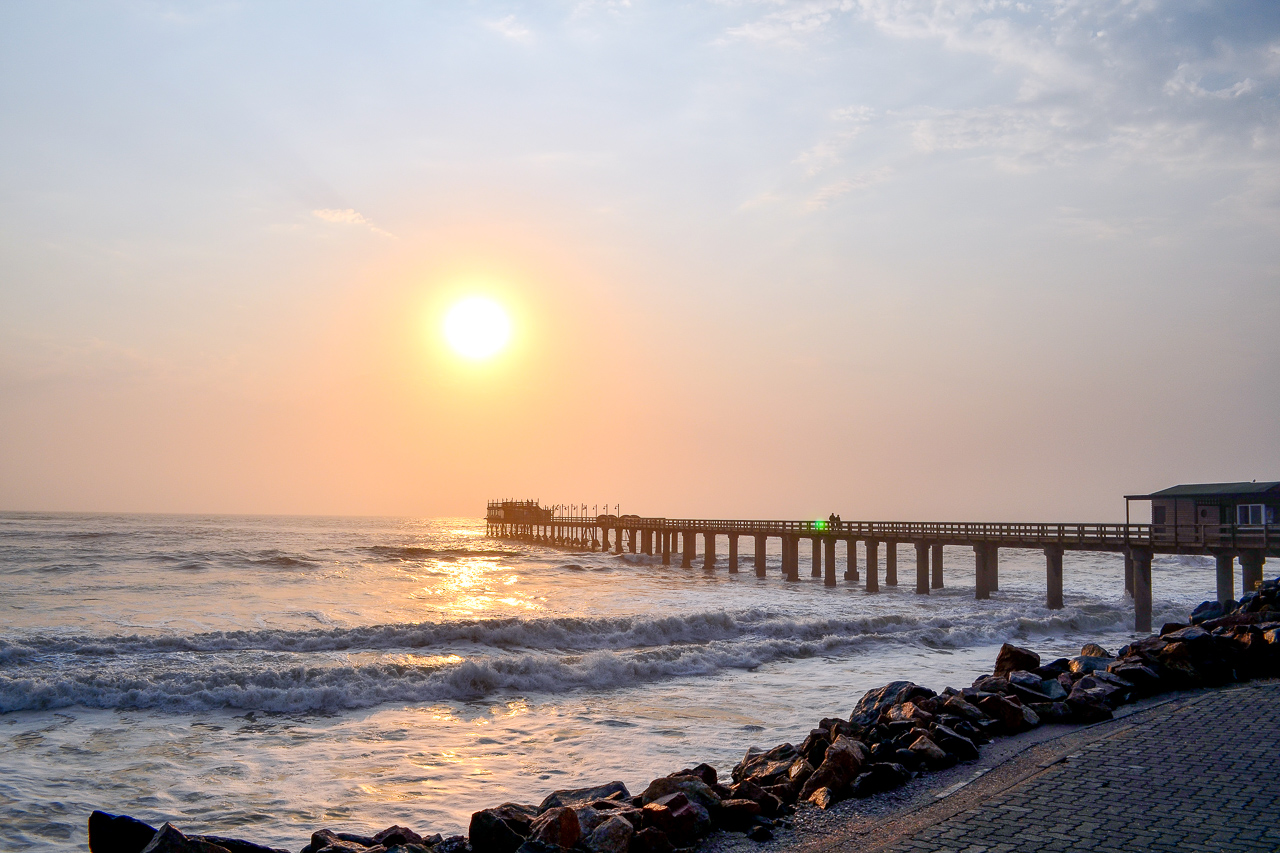

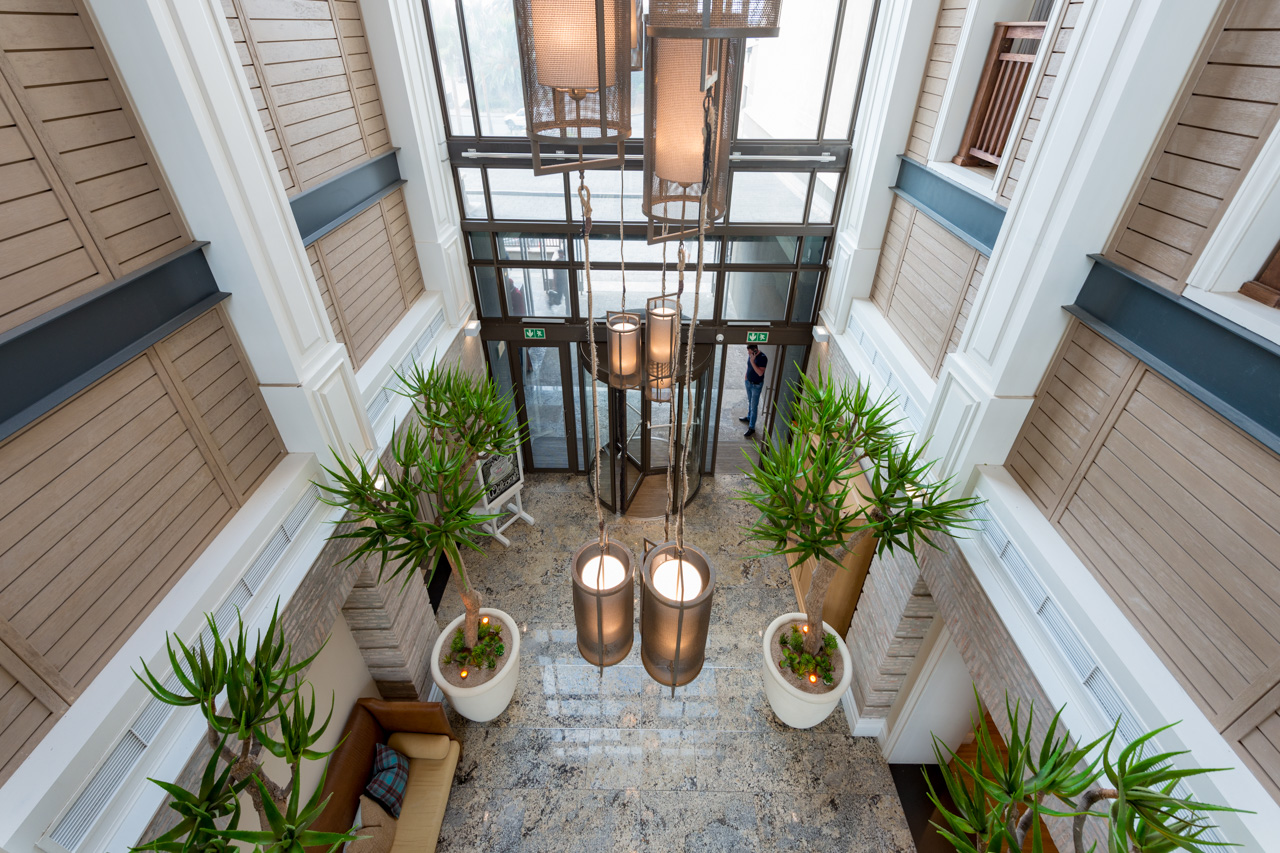
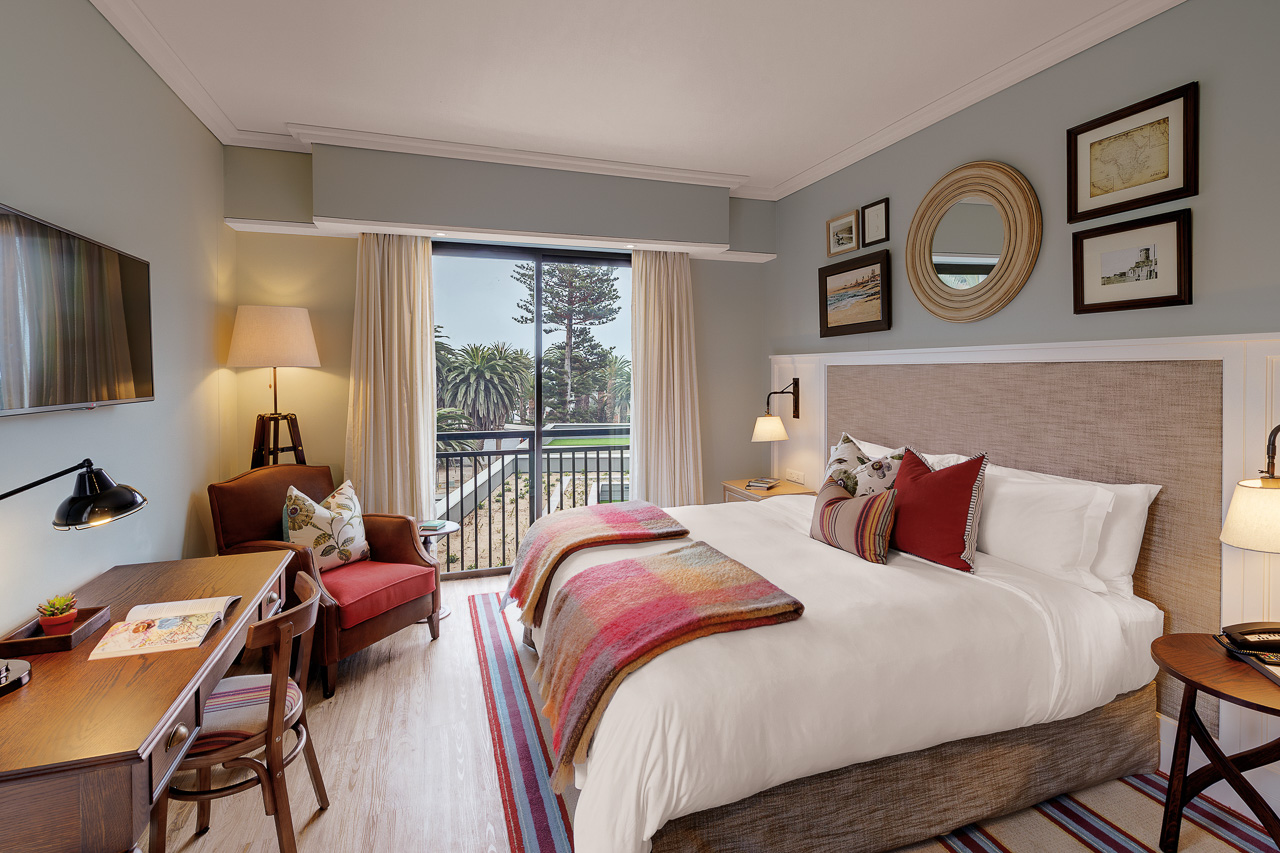
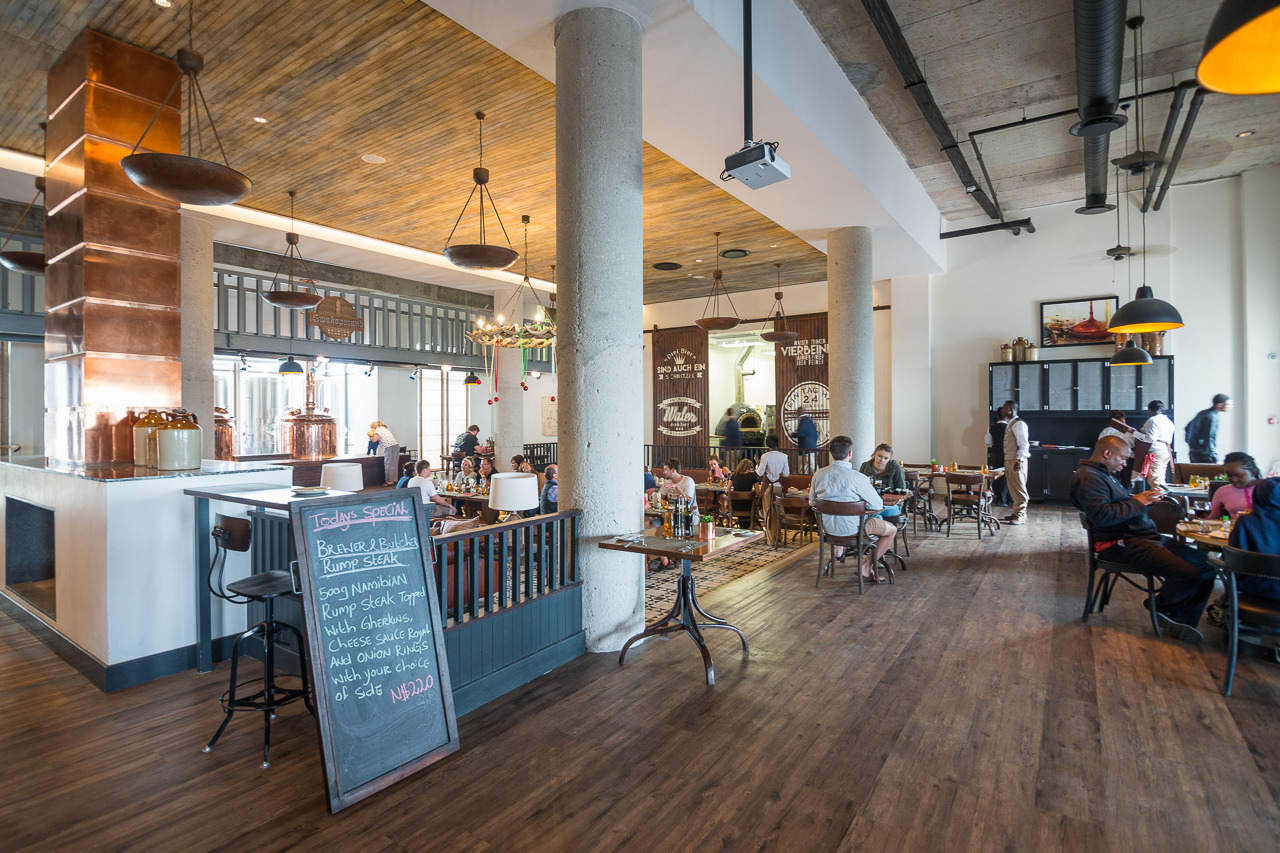
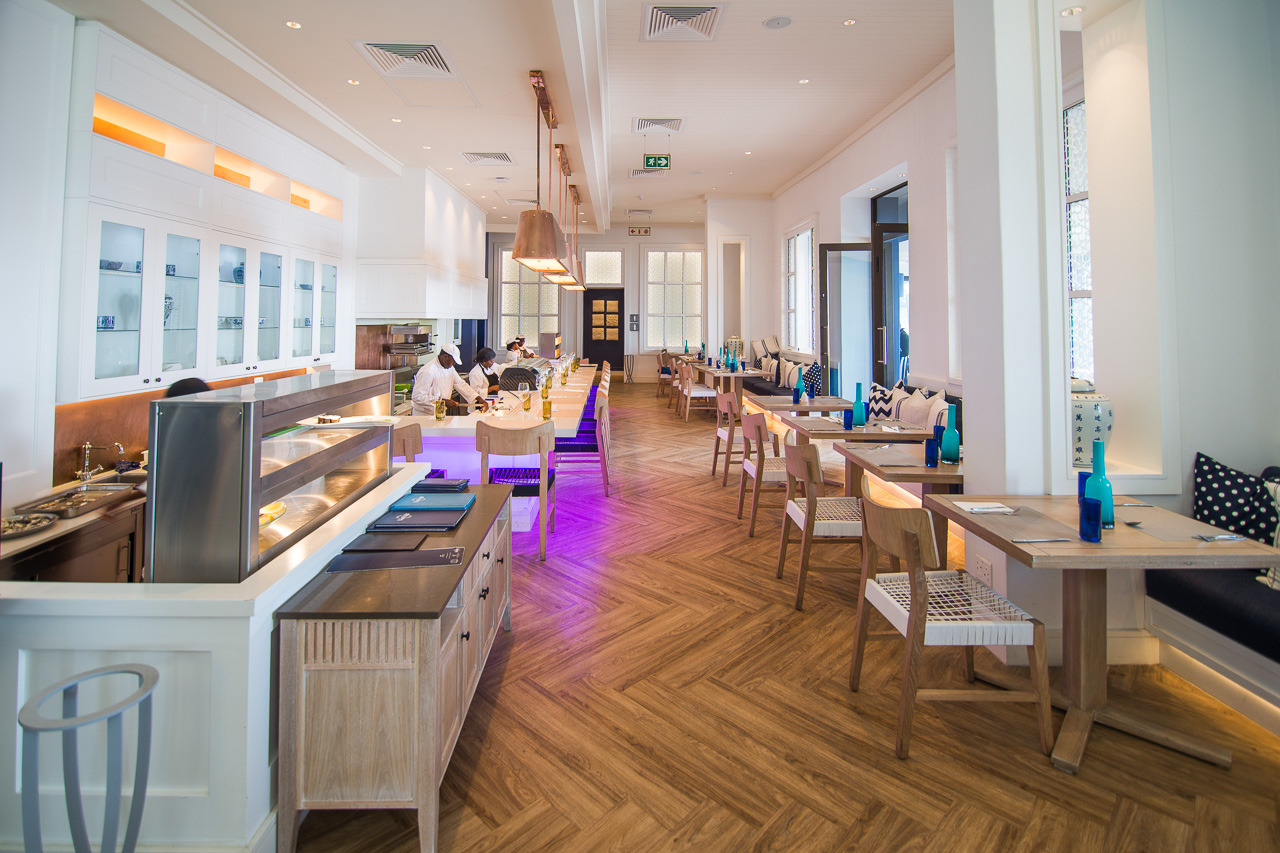
Accommodation The new Strand Hotel has set a new standard in Swakopmund. Uniquely located on the iconic and historic Swakopmund Mole and surrounded on three sides by the Southern Atlantic Ocean its 125 rooms and suites make this hotel one of the larger ones in town, but of those certainly the one with the best seaside location. All rooms have tea & coffee stations, mini-bars, hair-dryers, TV’s, free Wi-Fi Internet access, telephones and air-conditioning.
The Strand Hotel offers its residential guests and all casual visitors three exciting restaurants. The Farmhouse Deli is good for coffee, cake, sandwiches and fresh salads. The Brewer & Butcher welcomes beer and meat lovers. The Ocean Cellar caters for guests who prefer seafood, sushi, oyster and a glass of fine white wine.
The Strand Hotel is destined to become the social epicenter of Swakopmund for locals and tourists alike.
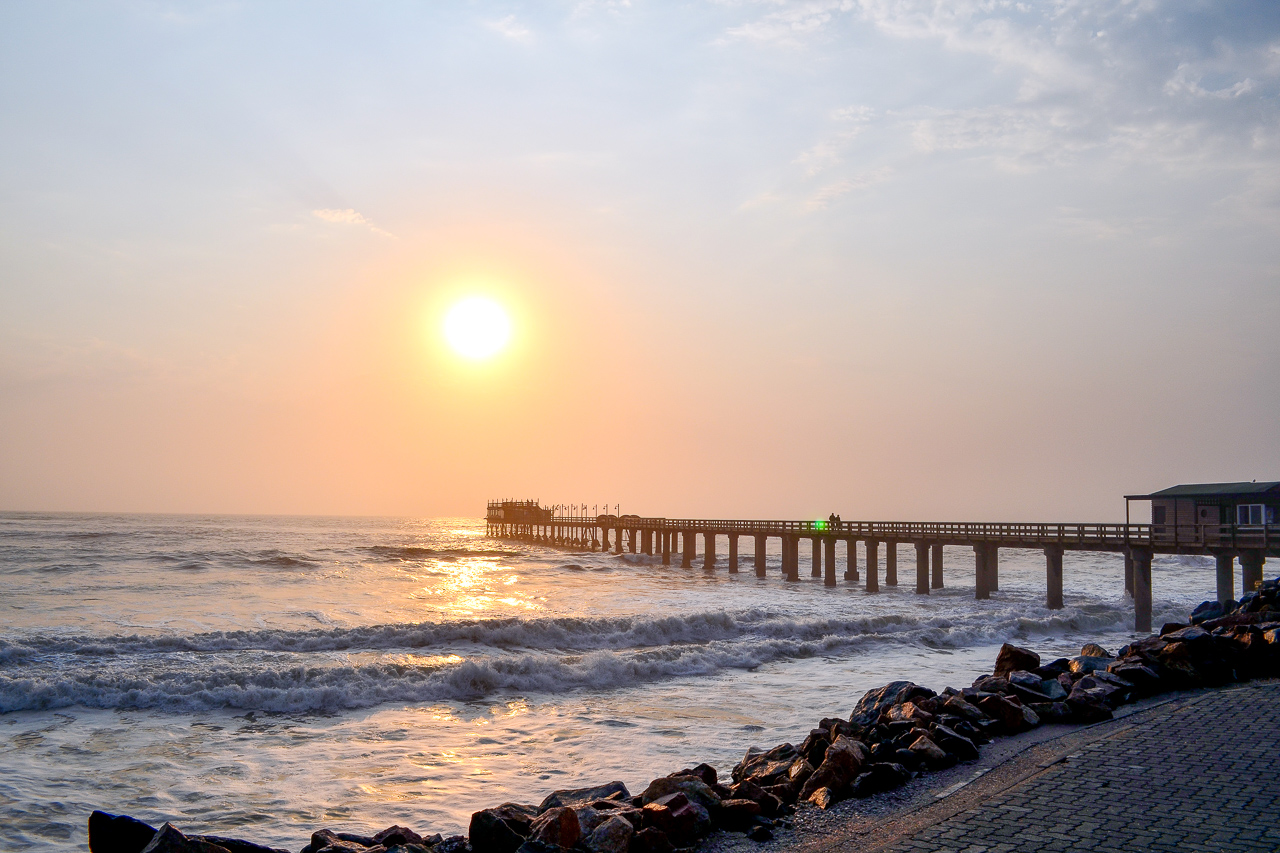
Swakopmund was the centre of German colonial rule, and relics of this chapter of its history can be found around every corner. Most noticeable of these is the long jetty, which stands witness to the German’s activities in this area and their attempt to create a usable port. Unfortunately, Swakopmund turned out to be wholly unsuitable for the task. Walvis Bay is a natural bay just 30 km south. It was occupied by the English as early as 1795, and later became a fish-processing industrial town under South African rule.
Swakopmund is charming. The old part of town is very pretty and offers several cafes, bakeries and, of course, the unavoidable beer houses. Time appears to have stood still in many parts, and it’s difficult not to keep rubbing your eyes in wonderment at the mix of German and African.
There’s a lot to do if you stay at Swakopmund: take a day trip southwards along the coast to Sandwich Harbour, hop on a boat at Walvis Bay and wait for the seals and pelicans to greet you, Kayak with seals, jump on a quad bike for a ride through the dunes, or just take a stroll along the beach and enjoy a tasty meal in one of the great restaurants. Swakopmund’s most famous landmark, the jetty, has been renovated and now boasts the appropriately named ‘Jetty 1905’ restaurant at its end.


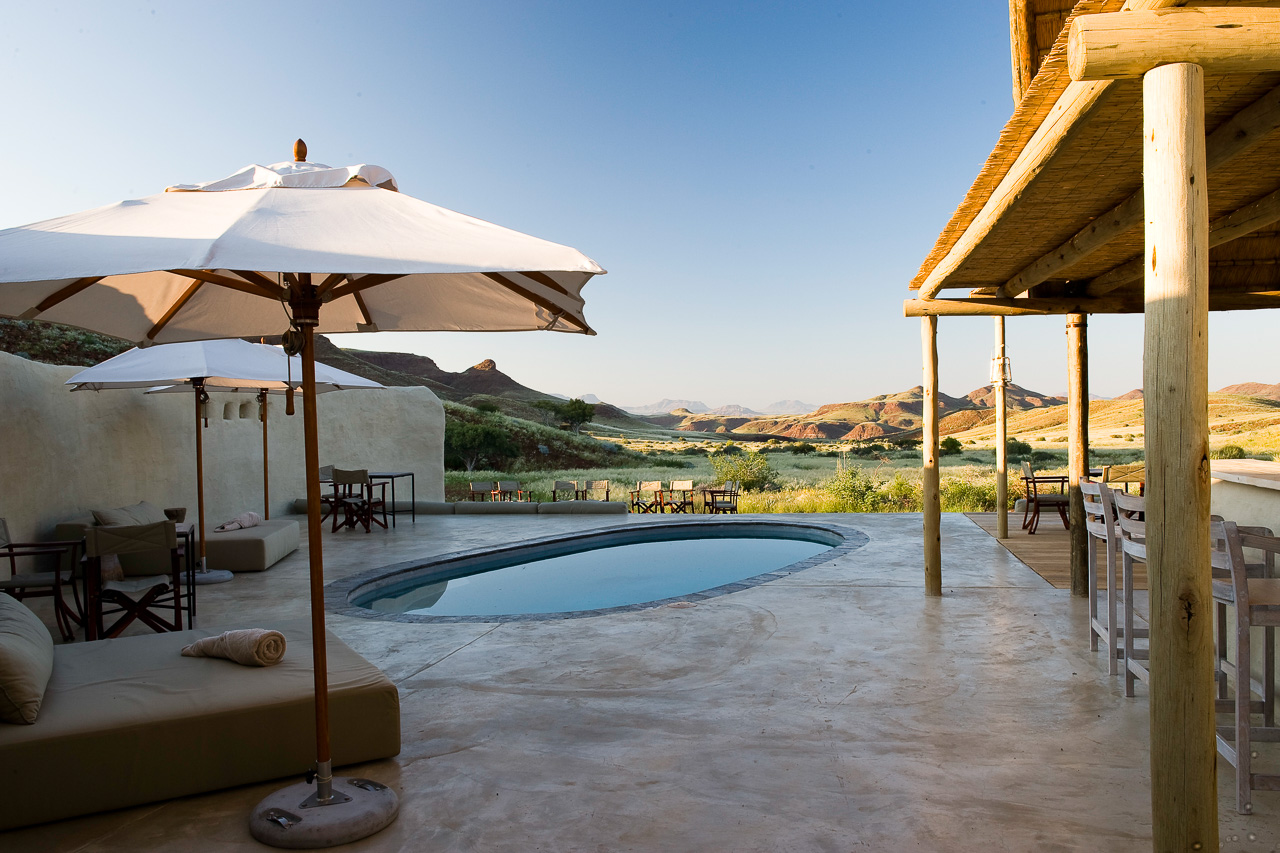
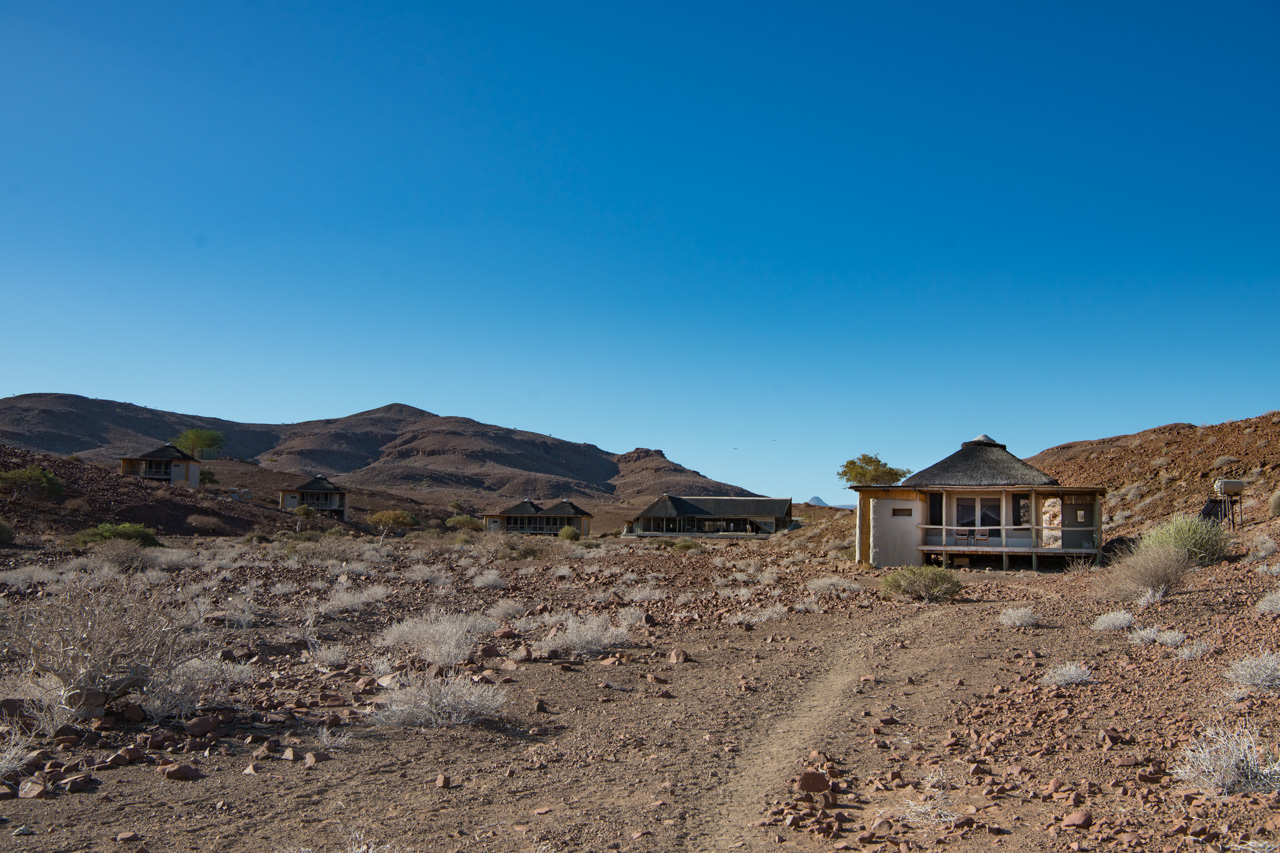
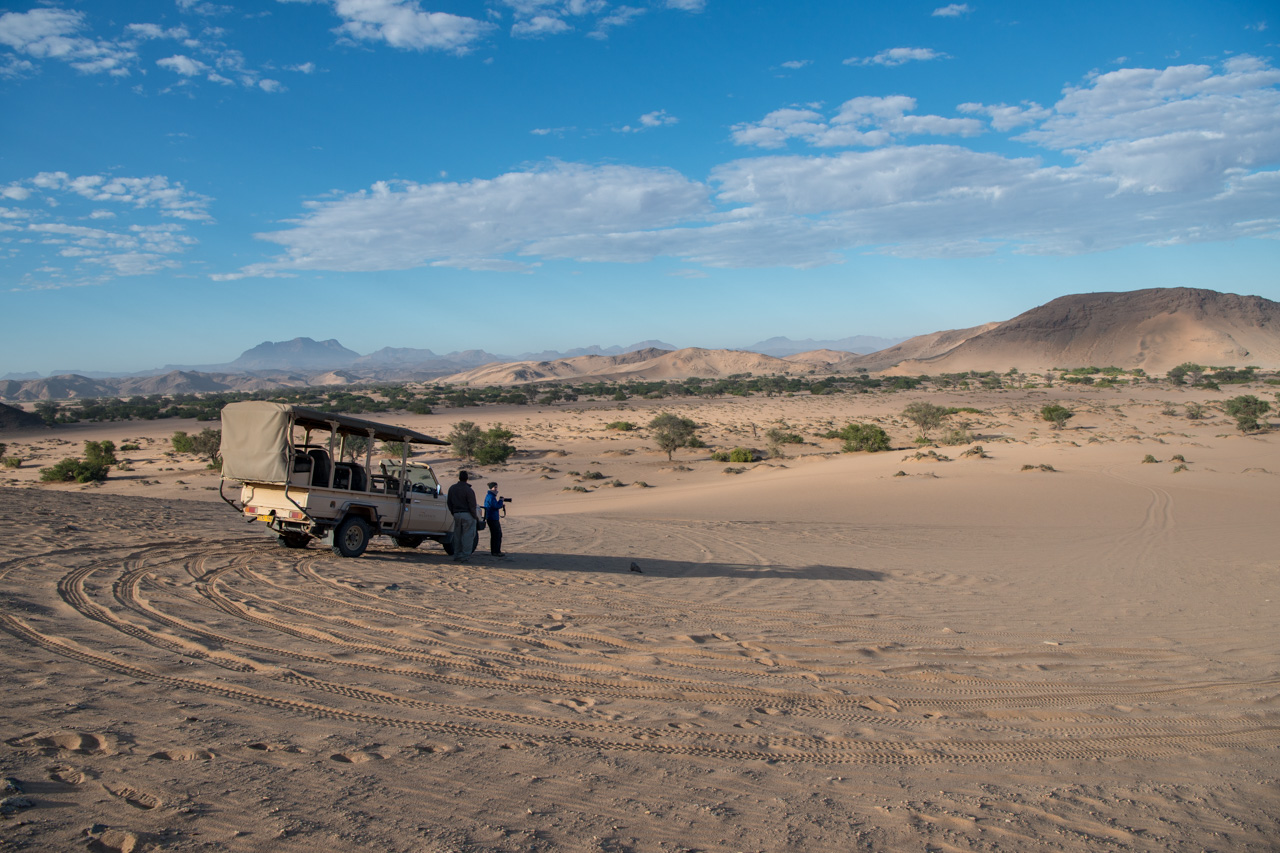
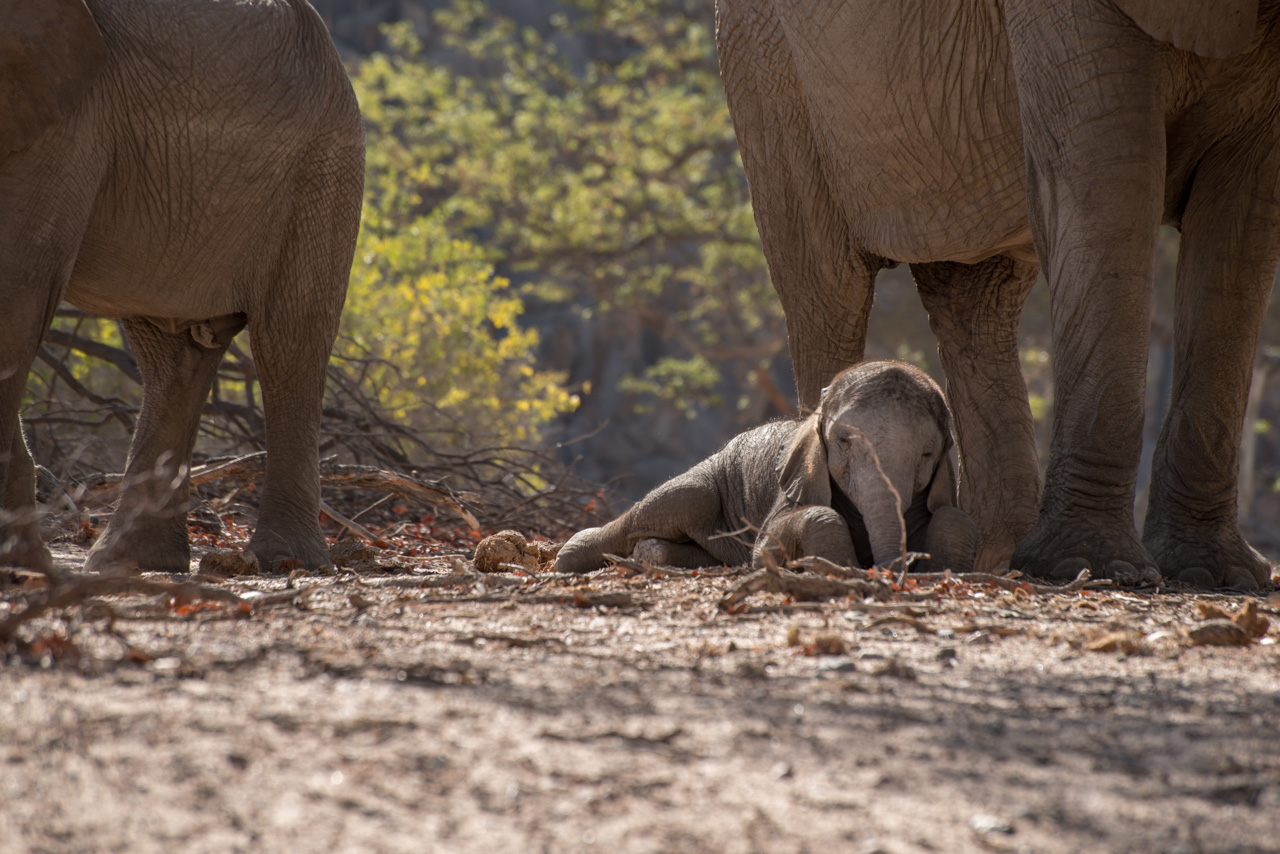
Accommodation Damaraland Camp offers ten thatched, adobe-style units in a modern interpretation of a traditional construction. The stylishly furnished rooms are distributed around the main building. Each is equipped with en-suite facilities and a large veranda, which comes into its own during the clear and starry desert nights. The main building is light and airy and houses a swimming pool, a bar and a lounge where guests can read, relax and unwind.
Damaraland is spectacularly beautiful, craggy and rugged with open plains. The whole landscape takes on a green hue after rain has fallen; a sight best viewed from above when arriving at the camp by air.
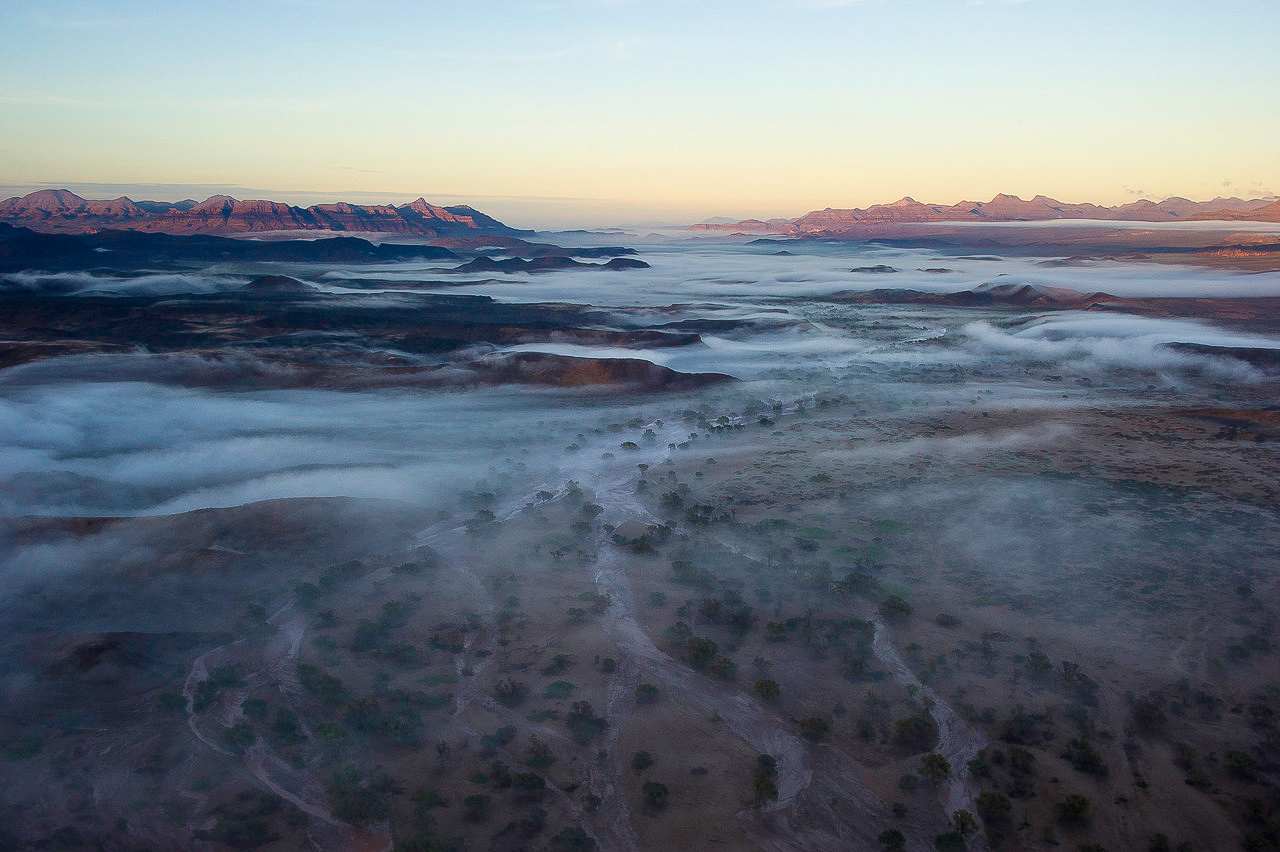
Famous formations include Namibia’s highest mountain (Königsberg in the Brandberg Massif, 2606 m), the Vingerklip (a rock needle) and the Spitzkoppe (Namibia’s 700 m high Matterhorn). It is also well worth visiting Twyfelfontein to see the world-renowned rock engravings – a little touristic, but also a World Heritage Site.
The remote west of Damaraland is particularly interesting. It includes the Palmweg Concession with its abundance of rhino, and the Torra Conservancy, which is also a haven for desert elephant.
Fog often forms over the cold water of the Atlantic at night, carrying much needed moisture to plants up to 20 km inland. Depending on the time of year, the fog disappears again shortly after the scorching Namibian sun rises. The densest fog can be found along Skeleton Coast during the winter months; the best weather can be found here from November to March (hot season).
Various rivers flow from east to west through Damaraland, but they are mostly dry and only flow during the wet season. The main rivers are called Huab, Ugab, Uniab and Koigab. The edges of these river valleys support trees such as mopane, camel thorn, ana tree and various shrubs, which in turn attract a list of animals from the surrounding area, including desert elephant, which has adapted to the region’s harsh and barren conditions. Other wildlife that can be spotted here includes oryx (gemsbok), kudu, Hartmann’s mountain zebra, giraffe and springbok. Visitors can also, but rarely, catch sight of lion, leopard and very shy rhino.
We love Damaraland because of its beautiful landscape. Spotting wildlife, such as desert elephant, just makes it all the more beautiful.
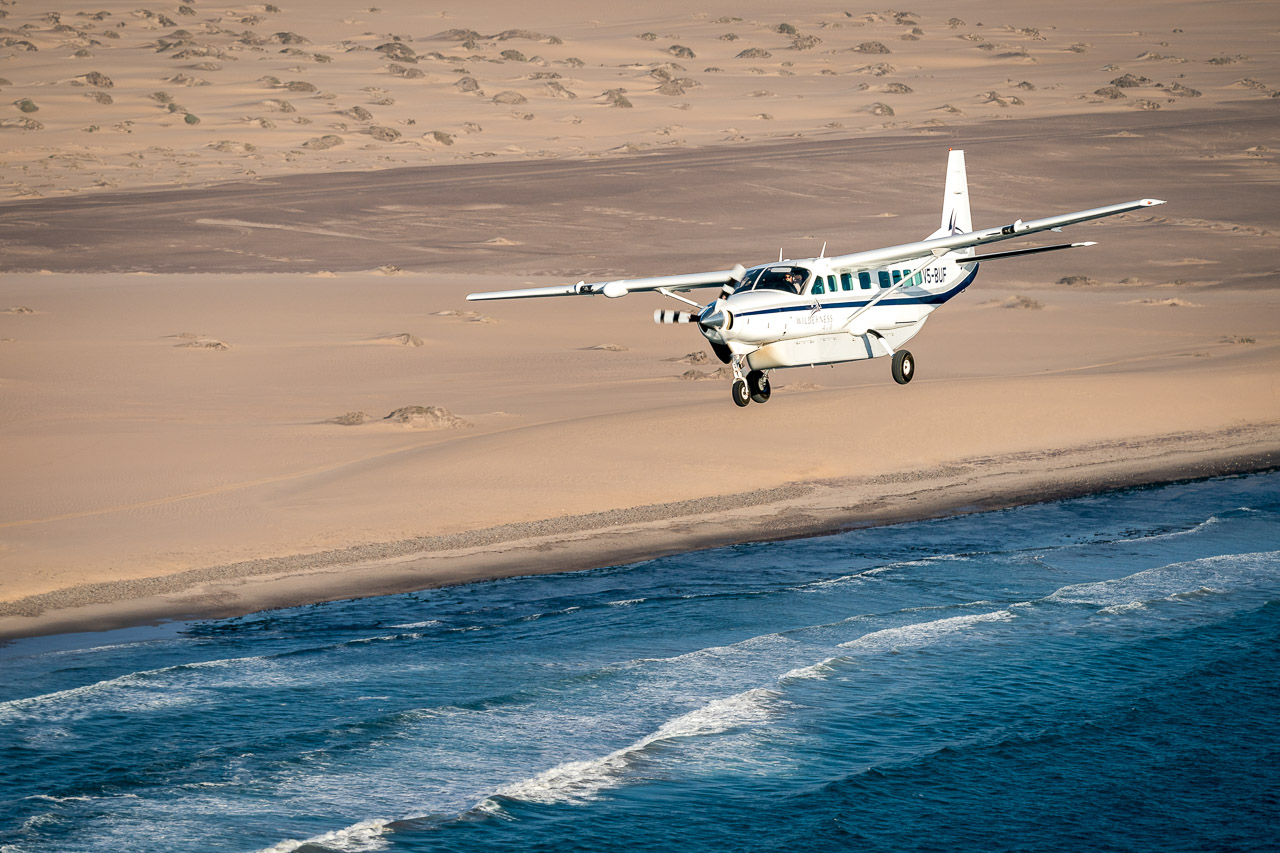

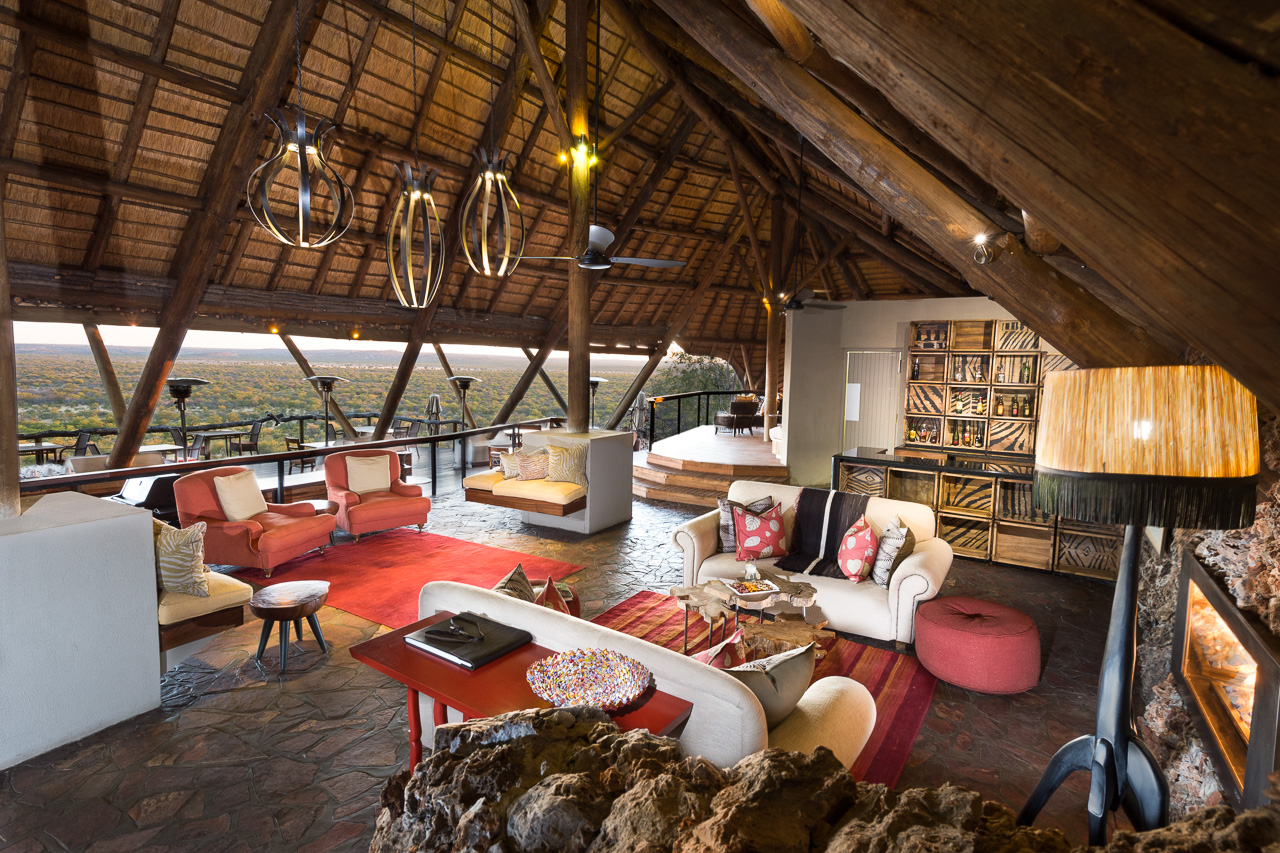
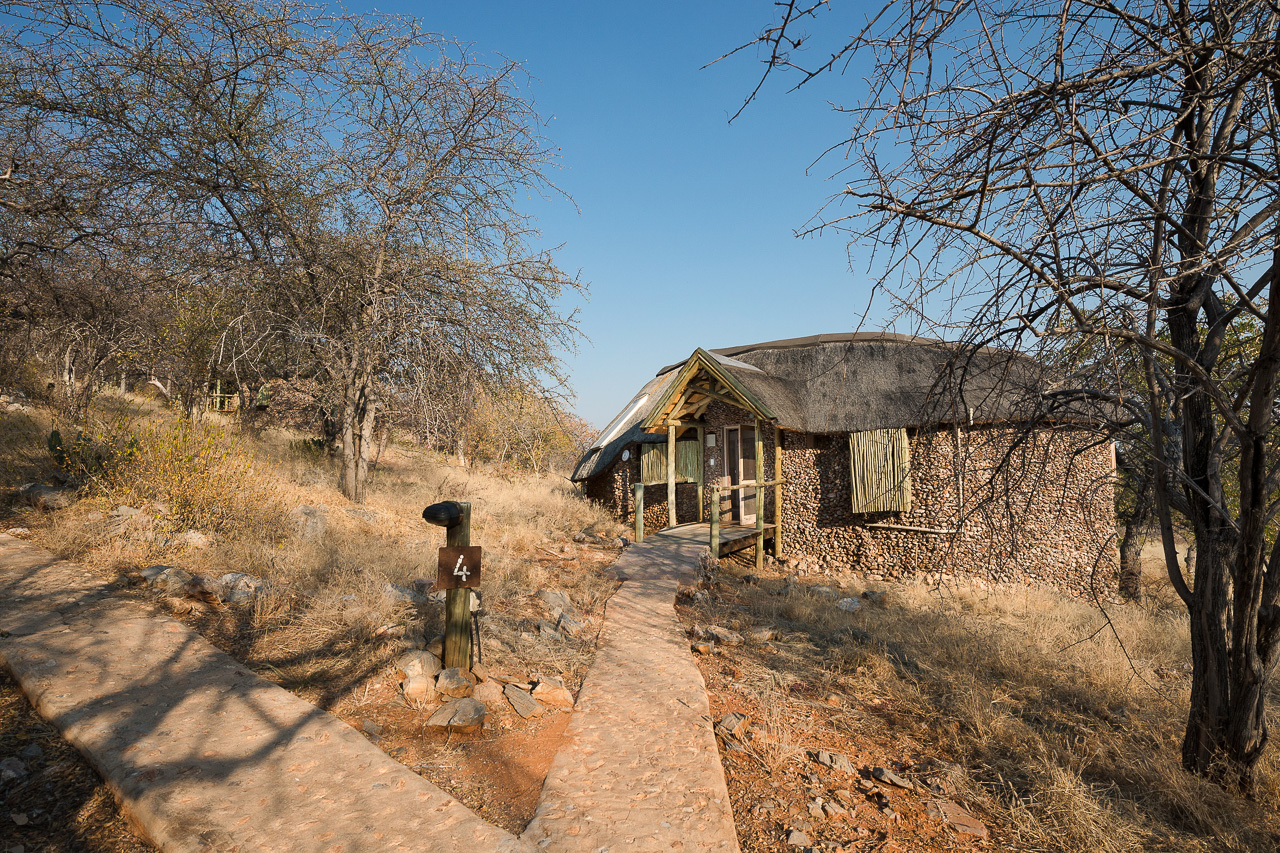
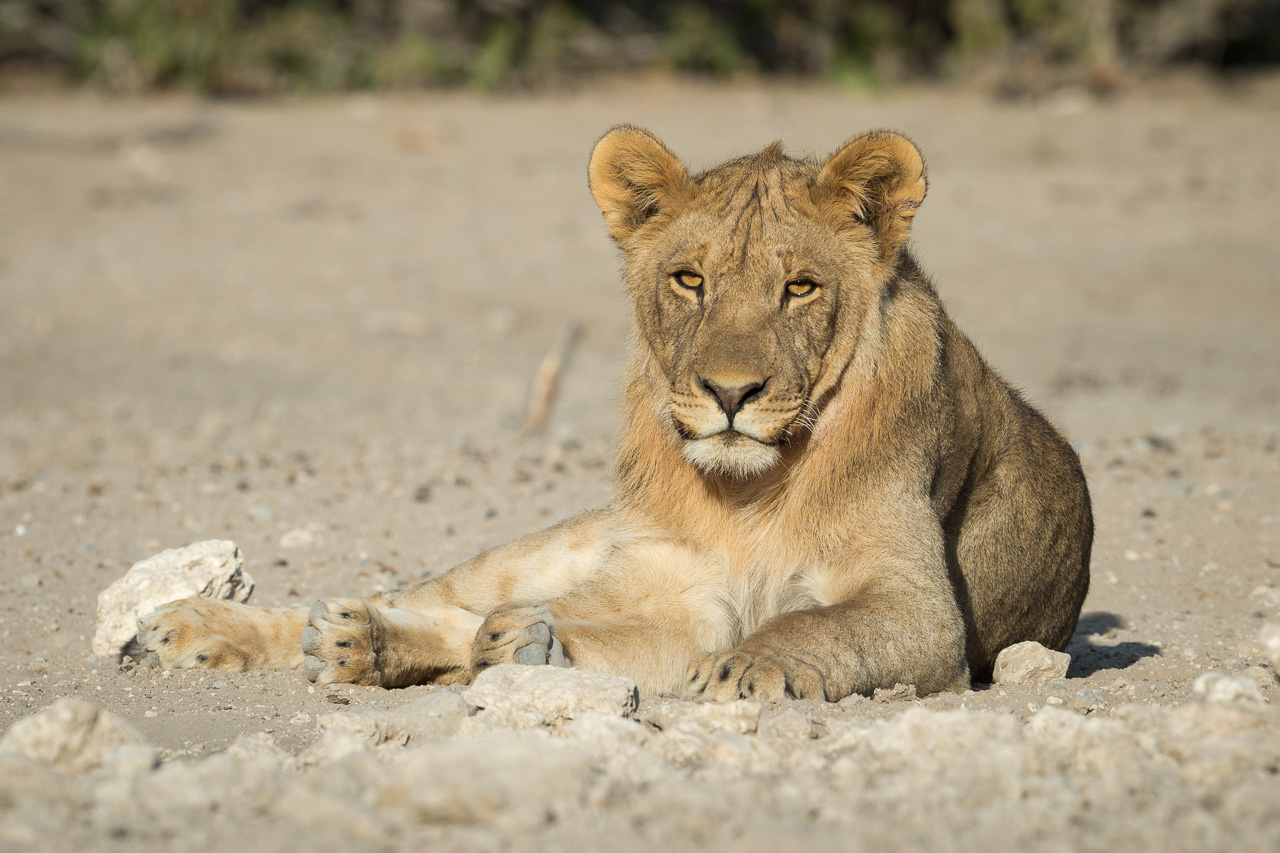

Accommodation
Constructed on a small hill, the lodge's fourteen pleasant, thatched stone houses with en-suite bathrooms and air-conditioning are spacious and comfortable. Each room has a beautiful terrace with loungers and an outdoor shower. The slightly raised main building offers a fantastic view of the waterholes. Meals are often served on the veranda, from where guests can continue to enjoy the spectacular vistas.
Andersson's Camp, Little Ongava and Ongava Tented Camp are also situated in the Ongava Game Reserve.
The Etosha National Park is one of the most important nature reserves in southern Africa. It exists since 1907 and covers an area of 22,270 km². The central and eastern sections consist mainly of various silvery-white shining salt pans, which have made Etosha famous. In the dry season the park, the animals and the vehicles are covered in a whitish haze of salt dust.
On the southern shore of the huge Etosha Pan (130 x 50 km) there are several waterholes, which magically attract the animals from the surrounding area during the dry season. The three large state camps Okaukuejo, Halali and Namutoni connect Anderson's Gate in the south with the von Lindequist Gate in the east. The western part towards Galton Gate is much more wooded and less frequented by visitors, but it also offers less trails to drive around and find wildlife.
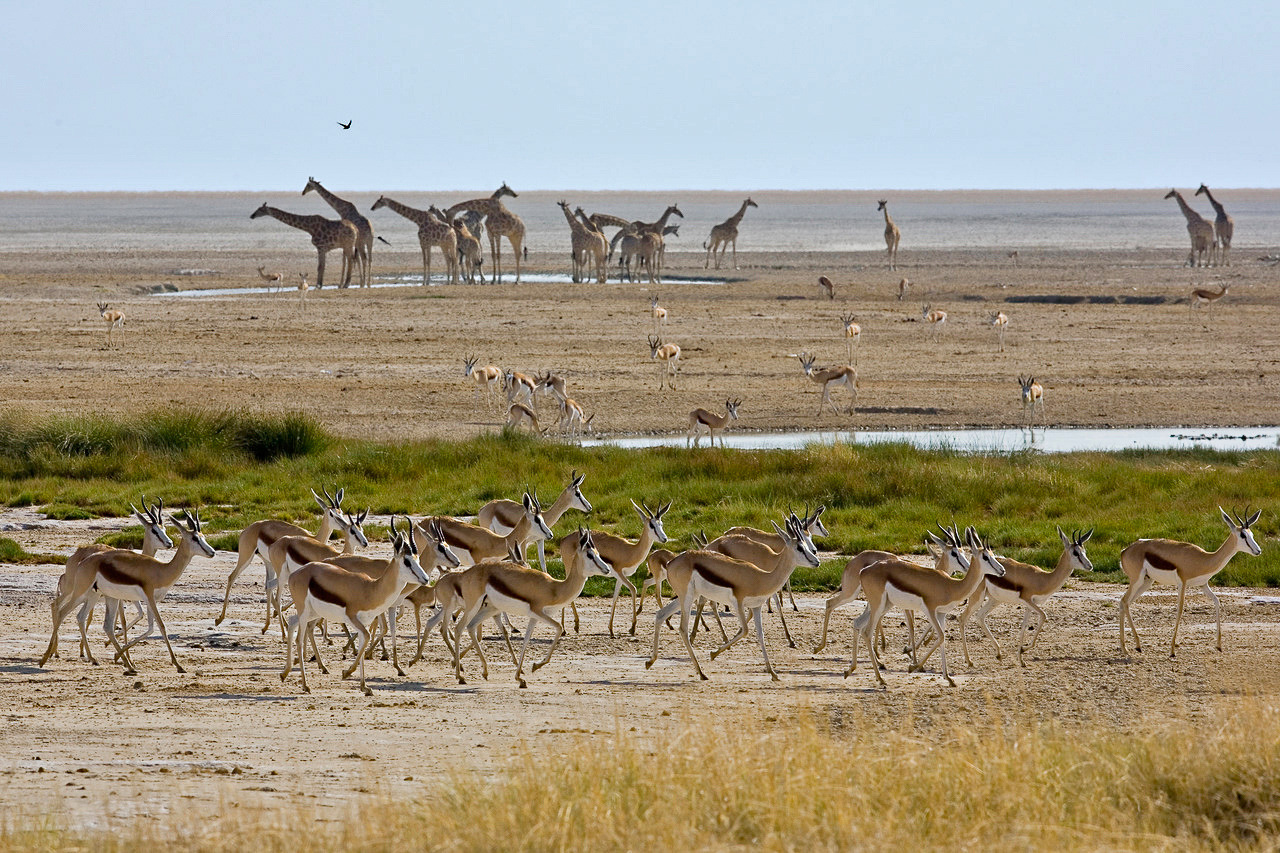
The park thrives mainly on these artificial waterholes, which attract countless animals in the dry season. With the onset of the rainy season, the animals are much less dependent on these waterholes and more difficult to find. The Etosha Pan itself can then contain up to 10 cm of water, and the park becomes more exciting for birdwatchers.
There are a few government camps in the park itself, most of which offer a less favourable experience. The good accommodation is located outside the park in private areas, in the east these are Mushara and Onguma, in the south it is the private Ongava area.
Namutoni and Okaukuejo are the two main camps at the eastern Von Lindequist Gate and the southern entrance to Etosha at Andersson's Gate respectively. The quieter Halali Camp is situated between the two. The state camps are very large and offer chalets, campsites, petrol stations and large picnic areas. If you are looking for a private experience, this is certainly not the place for you. Most of the roads run between these three camps and lead visitors to the various waterholes.
The western part of Etosha opened to visitors in 2011. This part of the park is very different from the area around the Etosha Pan, it has many more bushes and trees, less traffic, but also less to see.


Basic Information
Individual journey. The journey will be planned on your preferred dates.
Duration 9 nights. Minimum age 6 years. Weight limit of luggage 20 kg.
Includes all transfers from Windhoek to the hotels/camps to Windhoek
- Little Kulala: Standard Room. All meals, drinks (except premier brands), laundry service, twice daily shared activities with one of the camp guides.
- Strand Hotel: Luxury Room. Breakfast.
- Damaraland Camp: Standard Room. All meals, drinks (except premier brands), laundry service, twice daily shared activities with one of the camp guides.
- Ongava Lodge: Standard Room. All meals, drinks (except premier brands), laundry service, twice daily shared activities with one of the camp guides.
Learn more about these areas










